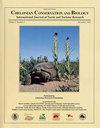Notes on Chelodina mccordi timorensis Biology, Harvest, Current Threats, and Community Perceptions in the Lake Iralalaro Region, Timor-Leste
IF 0.8
4区 生物学
Q3 ZOOLOGY
引用次数: 1
Abstract
Abstract The long-necked turtle Chelodina mccordi is considered Critically Endangered under IUCN Red List criteria. In Timor-Leste, the subspecies Chelodina mccordi timorensis is restricted to a small area of lacustrine habitat near the eastern tip of Timor around Lake Iralalaro in the Lautém District. We collected information on C. m. timorensis biology and harvest and assessed current threats and community perceptions. Data were collected during 2 surveys (February and July 2014) around Lake Iralalaro in Nino Konis Santana National Park. Threats were identified by direct observation, and local perceptions were recorded during expert interviews. Human harvest is the main threat in the area. Animals are captured using fishing line, are located using a bamboo stick in shallow water to probe the mud, or are captured by hand at the edge of the lake or under dry grass. Turtles are captured mainly during the dry season (April to October). Most experts identified C. m. timorensis under 2 different names according to the color (staining) of the plastron (veu = yellow and clear; sepe veu = dark and red). Local perspectives as to the population status of the turtle (stable, declining, or increasing) varied between 2 villages. Factors that may be reducing the capacity of this turtle to survive human harvest include predation by pigs and dogs. Fire and climate change are also likely to be important factors resulting in declines.关于东帝汶伊拉拉罗湖地区切罗迪纳·麦科迪·帝汶的生物、收获、当前威胁和社区观念的说明
根据世界自然保护联盟(IUCN)的红色名录标准,长颈龟被认为是极度濒危物种。在东帝汶,Chelodina mccordi timorensis亚种局限于劳特海姆区东帝汶东端附近Iralalaro湖周围的一小片湖泊栖息地。我们收集了关于帝汶弓形虫生物学和收获的信息,并评估了当前的威胁和社区看法。数据是在Nino Konis Santana国家公园的Iralalaro湖周围进行的两次调查(2014年2月和7月)中收集的。通过直接观察确定了威胁,并在专家访谈期间记录了当地的看法。人类收割是该地区的主要威胁。用鱼线捕获动物,用竹竿在浅水区探测泥浆,或者在湖边或干草下用手捕获动物。海龟主要在旱季(4月至10月)捕获。大多数专家根据板状体的颜色(染色)(黄色和透明;深红色=深红色)。当地对海龟种群状况(稳定、下降或增加)的看法在两个村庄之间有所不同。可能降低这种龟在人类捕杀中生存能力的因素包括猪和狗的捕食。火灾和气候变化也可能是导致下降的重要因素。
本文章由计算机程序翻译,如有差异,请以英文原文为准。
求助全文
约1分钟内获得全文
求助全文
来源期刊
CiteScore
1.70
自引率
14.30%
发文量
17
审稿时长
>12 weeks
期刊介绍:
Chelonian Conservation and Biology is a biannual peer-reviewed journal of cosmopolitan and broad-based coverage of all aspects of conservation and biology of all chelonians, including freshwater turtles, marine turtles, and tortoises. Manuscripts may cover any aspects of turtle and tortoise research, with a preference for conservation or biology. Manuscripts dealing with conservation biology, systematic relationships, chelonian diversity, geographic distribution, natural history, ecology, reproduction, morphology and natural variation, population status, husbandry, community conservation initiatives, and human exploitation or conservation management issues are of special interest.

 求助内容:
求助内容: 应助结果提醒方式:
应助结果提醒方式:


